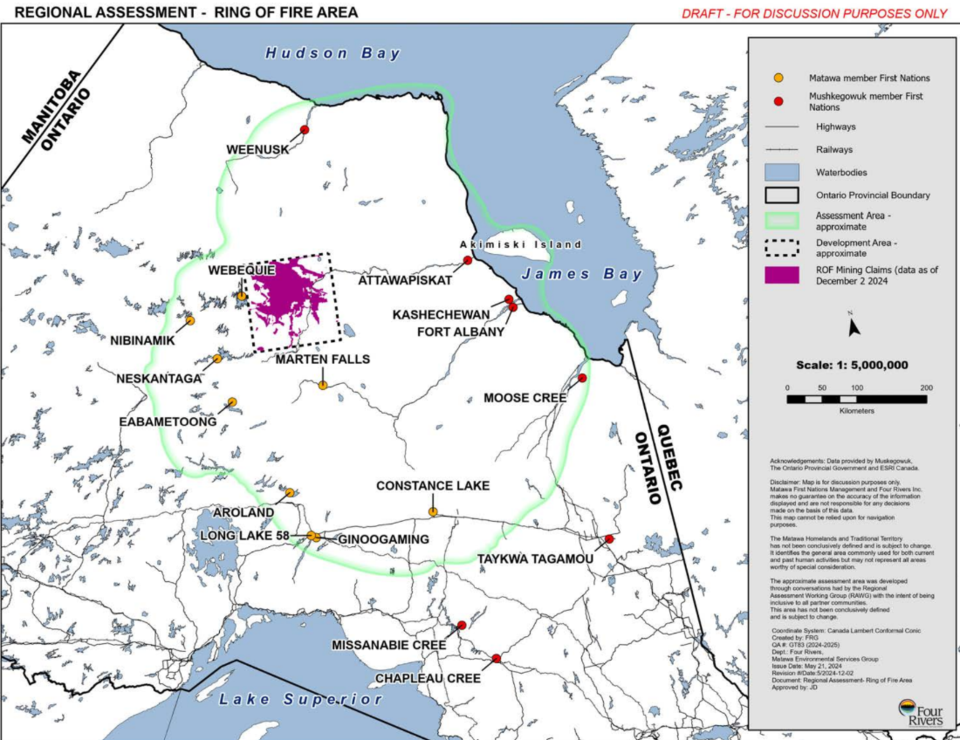OTTAWA - Almost five years after Ottawa called for a Regional Assessment of the Ring of Fire, the Impact Assessment Agency of Canada (IAAC) and 15 First Nations have defined a purpose and a plan.
In what the Ministry of Environment and Climate Change called a "milestone" for sustainable development in a Jan. 20 news release, the terms of reference have been finalized to begin the process of assessing the potential cumulative impacts of industrial development in Ontario's Far North.
It kicks off a two-and-half-year process — 30 months — before federal bureaucrats and First Nation partners turn out a final report on the pros and cons of the impacts of proposed mining activity in the James Bay region.
A federal news release and a background supporting document said this first-of-its-kind Ottawa-First Nations exercise will be led by a working group of administrators from IAAC and the Matawa and Mushkegowuk tribal councils.
The participating communities are: Aroland First Nation, Attawapiskat First Nation, Constance Lake First Nation, Eabametoong First Nation, Fort Albany First Nation, Ginoogaming First Nation, Kashechewan First Nation, Long Lake #58 First Nation, Marten Falls First Nation, Missanabie Cree First Nation, Moose Cree First Nation, Neskantaga First Nation, Nibinamik First Nation, Webequie First Nation, and Weenusk First Nation.
The Regional Assessment process is taking a holistic approach. It won't determine whether mining can or can’t take place but collect information through largely community dialogue and traditional knowledge gathering, to identify any potentially harmful impacts of mining. Indigenous values, interests and interests are being placed at the forefront.
The area being assessed comprises the communities and their traditional lands.
But a big question remains. Will the Regional Assessment process make it to the finish line with a federal election looming this year?
Should Opposition leader Pierre Poilievre become prime minister, he is threatening to scrap Bill C-69, the 2019 legislation upon which this process was based upon, and promises to make structural changes to the Impact Assessment Agency of Canada (IAAC) in order to trigger a nationwide resource boom and encourage investment in industry.
The Regional Assessment, a new and untried process, was introduced by then-federal environment minister Jonathan Wilkinson in February 2020 and subsequently handed off to Steven Guilbeault, who rejigged the process in 2023 to ensure it was ‘co-led' by area First Nations.
With the terms of reference now established, the working group has two months to develop a work plan — operating procedures, its timelines, meeting schedules and engagement opportunities — and, within 12 months, digitally post all the information gathered to date.
A final report will go out within 30 months to the participating chiefs and the federal environment minister. The document will lay out potential positive and negative effects of current and future development activities. Recommendations will be included.
Once the report is in the hands of the government and First Nations, they’ll collaborate to determine how to respond to the findings and recommendations.
IAAC said back in 2020 the findings will be used to only inform a federal environmental assessment of any future mining projects, whenever that formal process begins.
There is no mention in the document of how Ontario government processes factor into this exercise to avoid any potential unnecessary regulatory overlap or duplication.
Northern Ontario Business sent a query for a response into the provincial mines minister for comment. An answer was not immediately forthcoming.
Chromite and nickel were discovered in the McFaulds Lake area of the James Bay region in 2007-2008. The Ring of Fire is known as one of the largest untapped areas of coveted critical and technology metals in North America and the world. This wetlands region has never seen industrial development and the area First Nations are fly-in communities.
A permanent road network to connect these communities and reach the mineral belt has been proposed for many years. But nothing tangibly has been accomplished over the decades due to environmental and social well-being concerns expressed by some Indigenous communities, coupled with inertia and apathy by the provincial and federal governments.
The largest mine developer in the Ring of Fire, Australia’s Wyloo, wants to start construction on its Eagle’s Nest mine in 2027, paralleling the same timeline as the construction of an access road into the region. Wyloo officials were not immediately available to speak to how the assessment will impact their mine project timelines.



